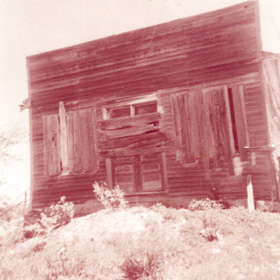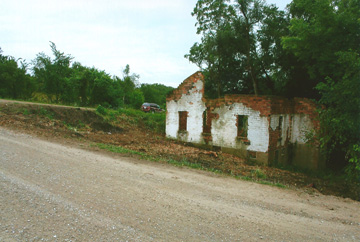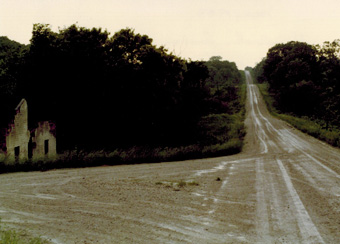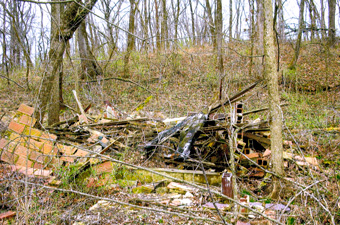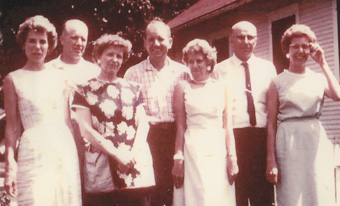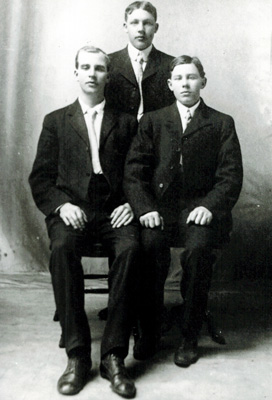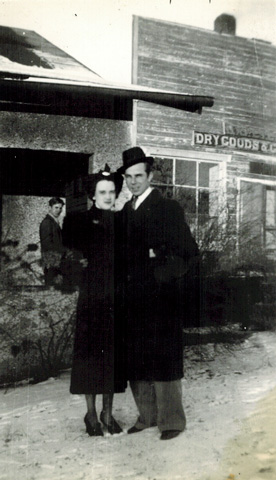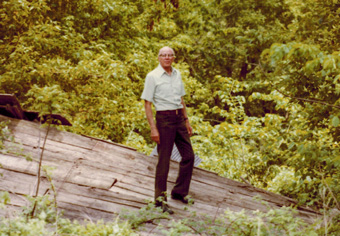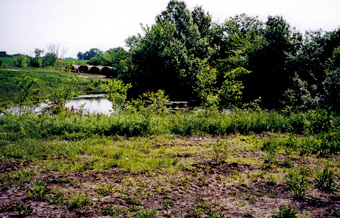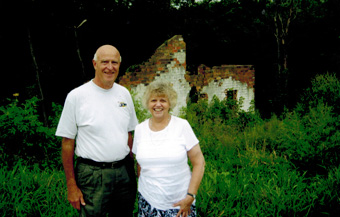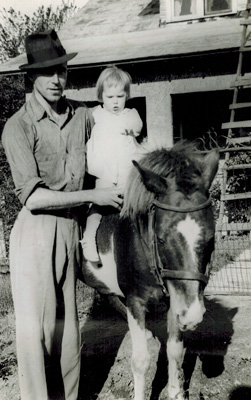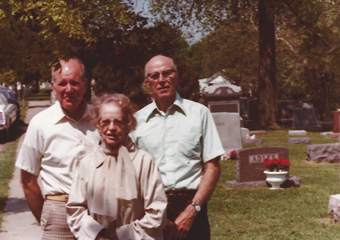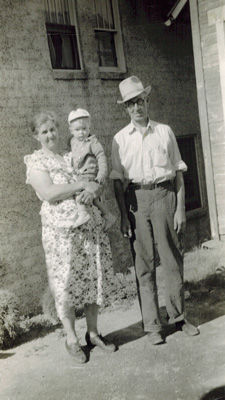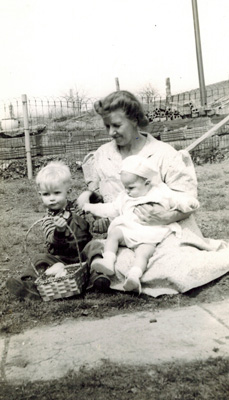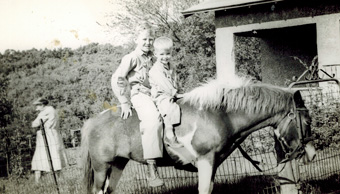
http://www.buxtoniowa.com • Consol, Haydock & Buxton Iowa, USA • 1871 - 2014
Haydock’s Peterson Store,
A Coal Mining Camp Legacy
The ruins of the Peterson Store in the coal mining camp of Haydock, Iowa are a lonely reminder of an era nearly 100 years ago when “Coal was King” in Monroe County and, for that matter, in the state of Iowa. Iowa was one of the top coal mining states in the nation with Monroe County (Albia, Iowa) it’s largest producer. During the heyday of the “Coal Dust Era” in Iowa from the mid 1910s to the mid 1920s, the Consol coal fields had replaced the Buxton coal fields. The mining camps in Consol, Bucknell and Haydock replaced the Buxton mining camps to a large extent as the home to the miners that worked coal mines #18 and #19 of the Consolidation Coal Company (CCC), 150 to 250 feet deep below the surface.
It was the decade from 1916 to 1927 that my grandfather, David A. Peterson, served the miners of the Consol coal fields from a store in the Consol mining camp. In 1922, he moved his family of ten from Consol to a new brick home and store in the mining camp that was called Haydock. Haydock was located four miles via Route H32 to the west of the Consol camp and nearer to CCC mine #19. The store and home were less than ten feet apart with the home to the south of the store. They were located at the southwest intersection of 160th Street (H32) and 527th Avenue (Melrose Road). The Melrose Road was considered, by most, as the dividing line between Bucknell on the east side of the road and Haydock on the west side. Since none of the camps were ever incorporated, dividing lines arbitrary. My article, “Where’s Haydock,” that was published in the Albia newspaper in November 2011, discusses in greater detail the dividing lines between the coal mining camps of Bucknell and Haydock. To further confuse the dividing line issue, that area was also called Midway. Depending on who you were talking to at the time, the Peterson store could be in Bucknell, Haydock or Midway!
The store was in an ideal location as it was “midway” from most every location in any direction. For that reason, the Peterson store was a common landmark point. Since the ruins of the store still remain. The store continues to this day to be a reference point for anyone traveling that area of western Monroe County. Terry and Sue Williams, who live one mile east on H32 from the “Peterson Store Corner,” refer to the corner as such when visitors to the area stop at their home for directions.
To me, the most interesting aspect of the store was that it was brick. Very few buildings were brick in the coal mining camps for the simple reason that the mining camps, buildings and all, would be moved from one coal field to the next. This was the case when CCC moved Muchakinock to Buxton in 1900, and then in 1916, moved Buxton for the most part to Consol, Bucknell and Haydock. To my knowledge, the only other brick buildings of any significance in the Consol coal fields was the miner’s wash house at mine #19, Art Armstrong’s meat market just north of #19 mine shaft and of all things my grandfather’s brother John’s “shack” to the south of the Peterson store. The brick ruins of these buildings still remain where they were nearly 100 years ago.
Before I go much further, I want to answer a question once posed by a writer that was doing a story on coal mining camps, i.e. ghost towns. As she gazed at the brick ruins of the Peterson home, she wondered who once lived there and what life was like during the “Coal Dust Era.” The writer got the story right since the so-called Peterson Store, as it is called now, was actually the Peterson home. The store was north of the house with just a 6-10 foot path separating the two buildings. The actual store was a wooden structure that was moved when the roads were re-graded in the 1940s. Who better to answer the writer’s questions in their own words than those who lived in the house from 1922 until they left home - my three aunts. Aunts Linnea, Elizabeth and Naomi, after I had badgered them for a number of years, agreed to write their memories of the house and of their lives in the house during the period from 1922 to the mid-1930s. Their story is as follows:
GROWING UP IN BUCKNELL, IOWA
Working together in 1998, Elizabeth Lund, Naomi Culmer and Linnea Colgan, three of the Peterson sisters, wrote this report of growing up in Bucknell, Iowa.
In 1922 we moved from Consol to Bucknell, Iowa (population 5,000) which was a coal mining town. Most of the population was foreign - Italians, English, Polish, Flemish, black and others. There’s a memory of the Ku Klux Klan but no memory of racial discord or discrimination among these people. We moved in to a new stucco home built by a friend of our father, Nate Peterson. It was five bedrooms up and one bedroom down with two large porches. A back porch which was enclosed. There was a living room, dining room, kitchen and pantry. There was a water pump in the pantry. It also had a basement which had Delco electricity. It was heated by coal. There was a range in the kitchen. Attached to the stove was a small reservoir for warm water. There was a heat stove in the dining room and we took our baths in a regular washtub behind the stove in the winter. Later years clothes were washed by hand and in the winter hung outside to dry. White clothes were boiled in the boiler to whiten them.
There was excitement moving in to a new town and new home. Our house was on a hill and our dad’s store was next door with a sidewalk between the house and the store. Roy and his friends played many hours in this area. The store was a general store with two large front windows on each side. One side had groceries and the other side dry goods. For cooling there was a large ice box. Farmers brought in their cream and Dad tested for butterfat. Today this process would not pass sanitation standards. They separated the cream. It was taken to Albia and made into butter. Our dad took grocery orders at the homes and Ray and Ivan delivered the groceries. No telephone was available at this time. Dad had an office in the store. He always wore his hat in the office and people didn’t realize he was bald headed.
We liked the store, of course, for candy. This was a large store with a back room and a basement with a trap door to the basement. Stepping out of the basement was a garage. Remember Dad was crippled from the mines, cranking to start his car took some effort. One time he broke his arm. We had a dog we all liked named Fritz. He was a watch dog. For the most part people were a little afraid of our dog. No one attempted to rob the store. Our dad went to Chariton for a good amount of his groceries from a wholesale house. The roads were dirt roads. He had trouble during rains getting stuck in the muddy roads. There were many hills. He was crippled after fractures. Very often after the stress of being out in the cold and rainy weather, he suffered dreadfully with his knees. It was so bad, sometimes he had to have medication for pain. there were times he suffered with knee pain other than stress.
In addition to wholesale groceries, there were salesmen who sold products to Dad. They liked Roy and gave him presents at times. After closing hours we often had people calling the house who wanted groceries. The response was “Who goes this time? Not me!” but they got waited on.
We had an ice house. Ice was cut from a pond and stored in the ice house with sawdust and they sold the ice. They also sold and delivered coal.
The mining camp had many company homes. They were all alike and not modern. The town was hilly and, of course, the houses were built on hills. There was a level area below the hills. Dad’s store was in Midway. There were approximately a dozen new private homes.
We have a memory of a foreign lady who kept animals in her home. She was often prancing up and down the hills and sometimes to the store. At the store she would say, “Me no like the country” and “son of a gun.” She was hard to understand and Mom was patient with her and tried to understand what she wanted.
There was Lambini’s ice cream parlor below the hill to the south of our house, a butcher shop across the alley, a post office and a company store. This was mine # 19. There was no mail delivery. There was a theater that showed silent movies. Above the hills there was Charley Armstrong Hall. He had a lunch room, a few groceries, and in the back a large area we called The Hall. They had dancing - square dancing - and roller skating. Also high school basketball. During our time at this area we saw no gambling or drinking. Other times? We played basketball in our school but never won - it was fun though.
There was a nearby drugstore with a fountain. Our high school was on Baxter Street and also another store was there.
This area was well taken care of. Nice lawns and streets, etc. The store was J.E. Larson’s. They and a beautiful home. Grandpa Nylander’s house was near there. It had been moved from Buxton. Elmer Larson lived there. J.E. Larson was the leader of our Sunday School. On Sunday afternoon we had Sunday School and church. The pastor was from Chariton. Christmas morning was Julotta, always a special Christmas time. We had a Christmas program and remember Bernie singing, “Away in a Manger” in the program. No Santa Claus. There was a Smorgasbord. There were lots of goodies and traditional Swedish food - homemade Swedish sausage and wonderful breads baked by our mom.
Dad got up early in the morning. First thing was the home fire burning. Then the aroma of coffee. From early childhood Elizabeth would be up drinking coffee with Dad. She still likes her coffee. One by one we rolled out of bed. Mom always prepared a good breakfast and as a family, we ate together. Our grocery store was convenient. When someone said, “We are out of butter,” the reply would be, “Run to the store and get it.”
There was no problem getting ready for school during the winter. During cold weather we wore long underwear and no snow pants. Our mother kept busy in the summer with her gardens and with canning. She had nice flowers. She worked in the store. She sewed quilts and crocheted. She cooked our meals. We thought it was really good cooking. They also had Ladies Aide.
After the mines closed in 1927, the store remained. People gradually left. Our mother took care of the store as Ray, Ivan and Lynn had gone. Liz, Lynn, Willie and Naomi graduated from high school in the 1930s. Liz went to Nurses Training in Rock Island, Illinois and graduated as a Registered Nurse in 1938. Ivan got a GED. Ray didn’t graduate and went to work in a garage in Albia. Our dad had a filling station at the Melrose Corners and Georgetown.
Additional notes:
Cars were Fords
Radios had large speakers
To use the telephone, you rang the operator
We watched the coal miners walking to work with large lunch buckets. They wore caps with a light on them. Coming home at 4 o’clock or so they were covered with coal dust. They were lowered in to the mines by hoist cages. There were mules in the mines pulling the coal cars. When someone was hurt, they blew a whistle. This was frightening as there was no doubt that there was an injury. The mines probably closed in 1927. They were on strike and never went back to work as there was no agreement. The coal remained - soft coal. People waited for a time but eventually moved away. They left many unpaid bills at our dad’s store.
Near us there was an elementary school. It didn’t last long as it was moved. They built a new high school and moved the elementary school to near the high school. Lynn and Willie made records for good attendance. The schools remained open even after the mines closed.
We children like to play paper dolls. We cut them from the catalog. Lynn liked to furnish rooms with cut out furniture. We jumped rope, played hopscotch, marbles, leap frog, annie annie over and ice skated. Naomi was a clown. One time she dressed as Popeye’s Olive Oil and Willie, Liz and friends went ice skating. This was a very fun time. We enjoyed all the games. We had disagreements and arguments. Naomi and Lynn worked together and Willie and Liz worked together. We even divided the dish washing. Lynn was always cleaning. Liz and Willie worked outside. Willie liked to read to Roy and Bernie. She was quiet. We enjoyed fairs in the summer. We went to Bussey’s 4th of July celebration. We had a case of pop, home made ice cream and fire crackers. We visited cousins and stayed over during the summer vacations. We visited Grandpa and Grandma Nylander. Grandpa loved children and gave them peppermints. He visited our house also.
Adult women wore long hair in a bun. It was not proper to cut hair but eventually this was changed but it took some time. Children usually had a bob with bangs. If the hair was curled, it was rolled on rags or a metal long clip. Make up was not acceptable. Most of our clothing was home made.
Some of my most prized photos as a 1-2 year old in the early 1940s include my grandfather and me walking hand in hand near the southeast corner of the house and my grandparents, Dave and Emma Peterson holding me in their arms as we stood on the north side of the house. In that photo, the corner of the store can be seen. I find it hard to fathom that during our visits in the early 1940’s, I slept in the house that now has become the “Peterson store” to all that view its ruins along Route H32(160th Street). As Paul Harvey would close his radio show by saying, “Now you know the rest of the story.”
The legacy of the Peterson Store in Haydock lies in it’s response to the miners need to feed their families during the strike period and before the coal company closed mines #18 and #19. The store fed hundreds of families all on credit with the thought that the miners would go back to work once the strike ended. The strike was never settled and the mines were closed. After the mines closed, many of the families left the coal fields without paying off their debts. In the meantime, the store had created a debt in the ten’s of thousands of dollars, due to credit. However, the Peterson store did pay off it’s debts thanks to my dad, Ray, and his brother, Ivan. They used the Peterson Store’s delivery truck to do hauling for the roads being paved in the Albia area. Somewhere buried in one of those paved roads is my dad’s and his brother’s caps. The tradition was that upon the completion of a stretch of road the workers would throw their caps into the last load of cement. The entry in the Peterson Store’s accounts payable ledger read, “Debt payed in FULL”.
